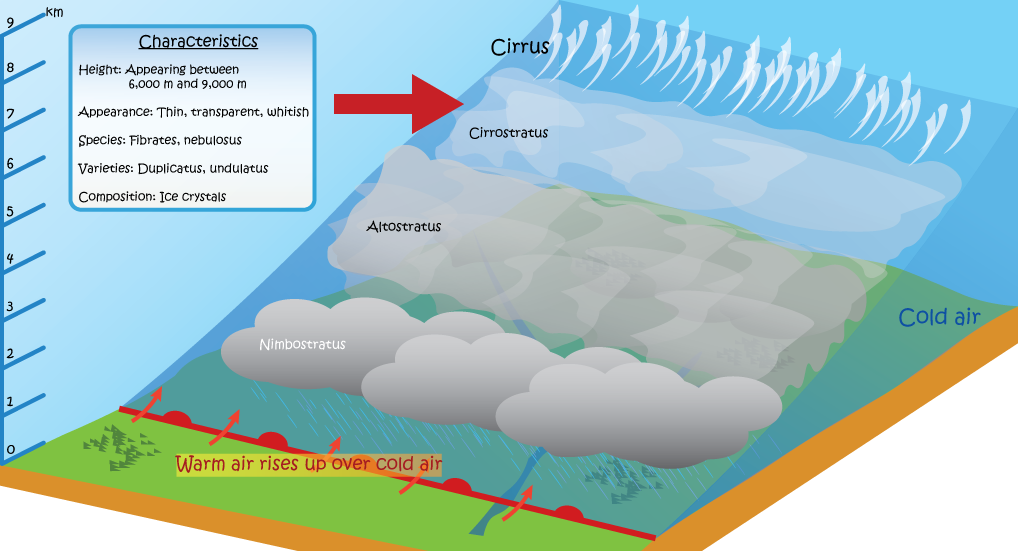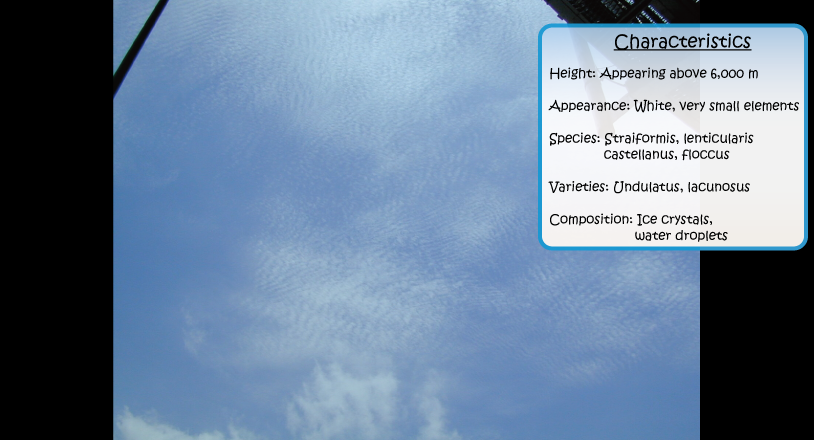High Clouds
High clouds are located at the highest level in the troposphere, normally around 5,000 to 13,000 metres above the ground. Cirrus, cirrostratus and cirrocumulus are high clouds. High clouds are often translucent. One of the main features is their resemblance of thin slices of white crystal-like glass. In fact, high clouds are mainly aggregations of ice crystals. The degree of translucence depends on the quantity of ice crystals, density and thickness of the cloud. 。

Cirrus is detached cloud in the form of white delicate filament, mostly appearing as a white patch or a narrow band. These clouds have a fibrous appearance, or a silky sheen, or a mixture of both.
Cirrus is whiter than any other genera in its vicinity. When the Sun is above the horizon, cirrus will remain white whilst other clouds are tinted yellow or orange. But when the Sun sinks below the horizon, cirrus will also get these colours and other genera at lower levels will become dark or grey. The reverse is true at dawn and cirrus will be the first to show colours.
What distinguishes cirrus from cirrocumulus is that the former appears in fibrous or silky form while the latter shows element of grains or ripples. The difference between cirrus and cirrostratus is that only the former has a discontinuous structure with limited horizontal extent.
According to the “International Cloud Atlas” published by the WMO, cirrus contains the following types:
Species: fibratus, uncinus, spissatus, castellanus;
Varieties: intortus, radiatus, vertebratus, duplicatus;
Supplementary features and accessory clouds: mamma.

Cirrostratus is a transparent whitish cloud veil with fibrous or smooth appearance, partially or totally covering the sky often in an irregular manner. Cirrostratus, when not covering the whole sky, may have clear-cut edges, otherwise trimmed fringes are fairly common. Its appearance and thickness do not change much with time and hence seems to be slow-moving.
The thin layer of cirrostratus is almost entirely composed of ice crystals. The occurrence of halo is a clear evidence of the presence of cirrostratus. Haze may sometimes have the appearance of cirrostratus, but it has a unique yellowish or brownish colour which distinguishes it from cirrostratus.
Shadow of an object will normally be cast on the ground when the Sun goes through cirrostratus. However it applies only when the elevation angle of the Sun is more than 30 degrees. Otherwise, the intensity of light will be much reduced as it travels a relatively long path through cirrostratus and is too weak to cast shadow.
According to the “International Cloud Atlas” published by the WMO, cirrostratus contains the following types:
Species: fibratus, nebulosus;
Varieties: undulatus, duplicatus;
Supplementary features and accessory clouds: None.

Cirrocumulus is a white patch or a thin sheet cloud without shading, composed almost exclusively of ice crystals. It often forms as a result of the transformation of cirrus or cirrostratus. It is rippled and subdivided into very small cloudlets in the form of grains or, ripples, most of which have an optical width of less than 1 degree. Care should be taken not to be confused with a dispersing altocumulus with tiny cloudlets on its edge.
According to the “International Cloud Atlas” published by the WMO, cirrocumulus contains the following types:
Species: straiformis, lenticularis, castellanus, floccus;
Varieties: undulatus, lacunosus;
Supplementary features and accessory clouds: mamma, virga.